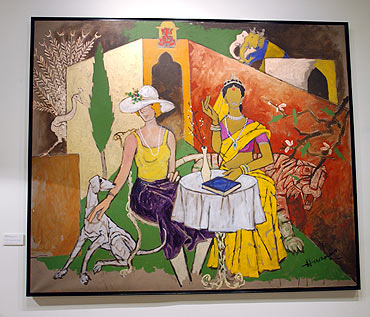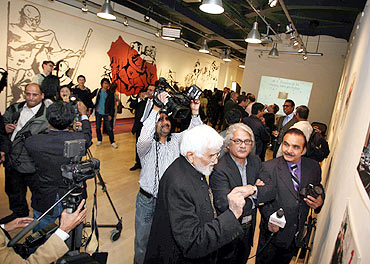Well-known artist Manu Parekh pays tribute to his dear friend M F Husain
He was Husain saab to me.
He was the man who knew how to arrive in New Delhi after a luxurious stay in Milan and walk straight to a dhaba in Nizamuddin-West. He did what he wanted to do.
Nobody can be like him. Ahha! What man he was!
I had premonition that he may not live for very long. His death makes me sad but it also fills my heart with nostalgia of the great life that he lived.
He, like Picasso, wanted to live for 100 years. F N Souza had lived abroad for many decades but he died in Mumbai in 2002. When he died I felt ...
'He was a nomad who loved India deeply'
Image: M F Husain paints during an exhibition in New YorkPhotographs: Paresh Gandhi/Rediff.com
He has acknowledged that F N Souza was his guru who brought him in fold of the progressive artists group in 1947.
Few decades back when Husain held a solo show in New Delhi, I proposed to let Souza inaugurate his show. Husain saab agreed and Souza, too.
Souza spoke of how he used to teach Husain. He spoke at length about Husain's paintings and profusely praised his talent.
Husain saab knew India so well because he had traveled to the nooks and corners of the country. He was an Indian nomad and loved India deeply.
He was so rooted in our land that his paintings brought out India in its true colours. He was a great painter but he was a fascinating person, too.
He had something inside him that would keep him on the move. He would stay at one place for three-four days and travel again. For many decades he traveled frequently but without a suitcase.
He would buy new clothes, colours and his stuff on arrival in the new city. Then he would leave behind many things because he preferred to travel light.
He enjoyed earning big money but he blew off money with elan, too.
Remember how he made Gajgamini with his own money? He didn't even care to distribute it properly. That was Husain -- he earned, he indulged.
'He was deeply religious and truly secular'
Image: A painting of M F HusainPhotographs: Paresh Gandhi/Rediff.com
There were many critics of his because he indulged in stunts, they alleged. But his stunts were grand. His madness was of superfine quality. He maintained the quality of his madness.
He could develop attachment and he could get out of it with ease too.
When you meet him you would find that the man is so detached from his possessions.
He knew the entry and exit of relationships. Although we heard he had many relationships, at same time he was attached to his family. He was a responsible head of the family and still managed to live the life of a wanderer.
He was a great painter who knew what Hindustan stands for and recognised what connects the people of Hindustan. He was curious, always. He was deeply religious and truly secular.
He never meant what some interpret about his painting of Indian devis. He was creating popular images. It was not done with bad intentions. It's not easy to draw Ganesh and Hanuman as he did.
One day I found him on the platform of Vadodara railway station. He was standing in the middle of a rustic crowd enjoying some colorful advertisement being displayed at the platform. He told me that he came from airport to the station because he felt like doing some sketches of Vadodara station. He then came to drop me at my compartment.
'Success sat light on his shoulders'
Image: M F Husain in an exhibition of his paintings in USPhotographs: Paresh Gandhi/Rediff.com
He enjoyed himself always. He was what we call, manmouji -- a man who carved out his own destiny. He would indulge in the barter system, give paintings to get something.
He understood money well and once he earned he did what he wanted to.
On one occasion, I found him at a monkey show by madari at the roadside in the morning in New Delhi. He said he had just arrived from Europe but his son is not at home. He was wearing a stylish leather jacket and trousers. What we dream of doing, Husain saab would just do it and enjoy it.
He ate malai and roti that morning for breakfast at a roadside stall.
The giant man was so natural and original. Success sat light on his shoulders so that he could enjoy himself.
Once he told me in pure Gujarati that he loves and firmly believes in one very popular Gujarati proverb 'bole ena bor vechay'. If loosely translated it means one has to market oneself. If you keep mum you can't sell your stuff at the bazaar. He had no confusion about his talking, communicating and selling.
But marketing was not all that he did. His genius lies in his understanding of India and its roots. He could enter into dialogue on Jainism, Buddhism and Hinduism.
He could correct you on the stories related Ramayana and his series on the Mahabharat remains my all time favourite.
'The man lived in his own masti'
As a painter, he moved my heart when I saw his painting Zameen, which is exhibited at National Gallery of Modern Art.
He had capacity to Indianise many trends and things.
It has elements from rural India. Only Husain can put kites and bullock carts in the modern context.
I saw him for the first time when I joined J J School of Arts in Mumbai. His solo show was in Mumbai around 1958. Husain had a white beard, he was wearing a hat made of cane. He was too slim and was wearing trousers with a thick belt. I asked someone who he is. He said, "He is a big artiste."
I was impressed by his persona at first sight.
Eventually, when we became friends, he told me, "Manu, if you reduce your tummy I'll draw your portrait." Once, he bought from us a painting of my wife Madhvi Parekh.
He had some magic to connect and remain light. Once in 1972, Husain saab, myself, his son Shamshad and painter Laxman Gaud met at his exhibition. He proposed to go for dinner. Instead of some fancy restaurant he took us to the crowded Nizams.
There was no space. Husain saab saw an Afghan having his dinner. He went and asked him if we can share the table. He allowed us.
Since it was dinner time, the waiters didn't come quickly to clean the table. Husain saab, simply picked up dirty dishes and started putting on table of cashier. Then he ordered food.
Meanwhile, the Afghan was getting impatient because his rotis were not served by the waiters. Husain saab simply gave away our rotis that had arrived.
Which man can do such things? He was a simple, light and natural. The man lived in his own masti.
The last time I met him in Dubai in 2009. He was living in a luxury apartment. He was engaged in drawing a series.
I could see, in our last meeting, that Husain saab knew how to be real Indian and then remain Indian and enjoy life thoroughly, the Indian way.






article